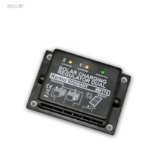wildebus
Full Member
- Messages
- 6,434
Seems to be lots of interest about how to get some charge into your Starter Battery from your Solar Panels.
The following is a way to replicate a setup that is very common amongst Self-Builds with basic Split-Charge setups, but this one is focused on the Solar Side rather than the Alternator.
Use a TEC 3M Relay (often used for Towbar setups for Caravans)

Connect the Leisure Battery (via a 30A Fuse) to Terminal 12
Connect the Starter Battery (via a 30A Fuse) to Terminal 6 or 2
Connect Ground to Terminal 0V
When the Leisure Battery reaches a certain voltage (around 13.3V), the relay will enable and the Starter Battery will be connected to the Leisure Battery and will get charged as well.
Once the Leisure Battery drops below a certain voltage (around 12.8V), the relay will turn off and the Starter Battery will disconnect from the Leisure side of the camper.
So in practical terms, when the solar panels start to provide a charge into the Leisure Battery, the relay enables; and once dark and the charging voltage goes, the Leisure Battery voltage will start to drop and the relay disables, ensuring that any power demands in the evening don't come from the Starter Battery and that is safe from over-discharge.
Also, the same effect will happen if you use a mains battery charger on the Leisure Battery, so you can charge both batteries with a single charger.
It might be worth fitting a switch to stop the relay coming on for times you don't want to have the Starter Battery connected during a Leisure side charge - in which case, fit a switch between the 0V and the Ground as that is the lowest power signal line so 'nicest' for a switch.
Good source for relay is https://www.pfjones.co.uk/towbar-electrics-charge-relay-tec3m.html
Cost of the above setup is under £15 including Relay, switch, fuse holders and cable.
The above info should be applied depending on what setup you have in your van. Like all wiring, it may or may not be appropriate to your requirement or configuration.
Enjoy
The following is a way to replicate a setup that is very common amongst Self-Builds with basic Split-Charge setups, but this one is focused on the Solar Side rather than the Alternator.
Use a TEC 3M Relay (often used for Towbar setups for Caravans)

Connect the Leisure Battery (via a 30A Fuse) to Terminal 12
Connect the Starter Battery (via a 30A Fuse) to Terminal 6 or 2
Connect Ground to Terminal 0V
When the Leisure Battery reaches a certain voltage (around 13.3V), the relay will enable and the Starter Battery will be connected to the Leisure Battery and will get charged as well.
Once the Leisure Battery drops below a certain voltage (around 12.8V), the relay will turn off and the Starter Battery will disconnect from the Leisure side of the camper.
So in practical terms, when the solar panels start to provide a charge into the Leisure Battery, the relay enables; and once dark and the charging voltage goes, the Leisure Battery voltage will start to drop and the relay disables, ensuring that any power demands in the evening don't come from the Starter Battery and that is safe from over-discharge.
Also, the same effect will happen if you use a mains battery charger on the Leisure Battery, so you can charge both batteries with a single charger.
It might be worth fitting a switch to stop the relay coming on for times you don't want to have the Starter Battery connected during a Leisure side charge - in which case, fit a switch between the 0V and the Ground as that is the lowest power signal line so 'nicest' for a switch.
Good source for relay is https://www.pfjones.co.uk/towbar-electrics-charge-relay-tec3m.html
Cost of the above setup is under £15 including Relay, switch, fuse holders and cable.
The above info should be applied depending on what setup you have in your van. Like all wiring, it may or may not be appropriate to your requirement or configuration.
Enjoy

